History and process of the Textile Industry

This is the central element of the project “Del Campo al Aparador” (From the field to the apparel), driven by CANAINTEX as a Business Plan between the Federal Government and the private initiative. This allows the integration of the Greatest National Content to all the production chain, aligning itself to the objectives of the National Development Plan 2019-2024.




